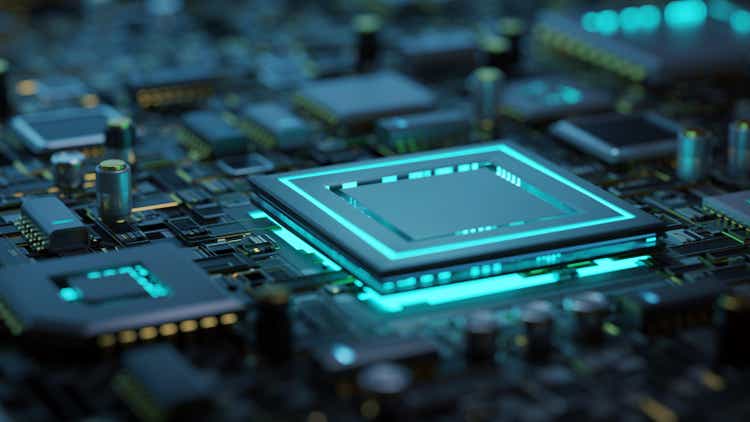
sankai
sankai
The semiconductor sector continues to be the worst performing cohort in equities this year. The combination of softening PC demand in the post-pandemic era and weakening consumer spending amid rising recession risks have already led to a flurry of performance warnings from chipmakers in recent weeks. And a recent tally of global PC shipments in the third quarter, which showed a rapid decline in demand from -6.8% y/y in 1Q22 and -15% y/y in 2Q22 to now -19.5% y/y in 3Q22, was enough to send the Philadelphia Semiconductor Index on its way “to the lowest since October 2020” during Tuesday’s session (October 11), underscoring the dour outlook ahead.
In addition to unravelling demand within the semiconductor sector that rapidly turned a multi-year boom into a rapid bust this year, recent regulatory changes driven by intensifying geopolitical tensions have only compounded pains. AMD (NASDAQ:AMD) and Nvidia (NASDAQ:NVDA) became the two most high-profile American fabless chipmakers being entangled in the U.S. government’s latest decision to ban the export of certain chip technologies to China, with both companies having already suffered a marked slowdown to their respective fundamental performances in recent quarters, snapping earlier runs of upbeat reports.
Despite cyclical and geopolitical headwinds in the near term, both chipmakers remain the backbone of critical next-generation technologies, and industry leaders within their respective expertise – namely, PC CPUs and server processors for AMD, and GPUs and AI for Nvidia. And accordingly, both are expected to emerge better than most that have been impacted by the near-term demand slowdown and recent regulatory changes.
But with the semiconductor sector’s valuations still higher than historical lows last observed in 2018, and a current macro backdrop that remains weak with mounting uncertainties spanning recession risks, entrenched inflation, and monetary policy tightening that have yet to resolve, we expect further volatility in both AMD and Nvidia shares. Market response to their respective earnings results and peers’ commentary on the industry’s forward outlook given the added complexity of recent export restrictions to China could weigh on the stocks’ performance further over the coming weeks and months, potentially creating compelling entry opportunities.
The following analysis will provide a detailed discussion over the context of the U.S. government’s ban of chip technology exports to China, and its potential implications on both AMD and Nvidia’s near-term fundamental and valuation prospects. While we remain optimistic on both chipmakers’ long-term upsides, we believe AMD makes a better buy for now on the basis that its exposure to the recently imposed export restrictions, as well as its valuation premium to peers, are relatively lower compared to Nvidia’s.
Following the U.S. government’s notice to chipmakers of interest – including Nvidia and AMD – last month over its intentions to curb exports of advanced semiconductor technologies to China, Washington has laid out details over said restrictions last Friday. Aimed at curbing China’s growing influence over the supply chains of key semiconductor end-markets, and limiting the rival economy’s military advancements, the latest export restrictions are primarily levied on innovative chips for AI and high-performance computing (“HPC”), as well as related manufacturing equipment:
More than half of corporations are expecting cloud adoption to account for a significant portion of investments in the next two years, driving the global cloud-computing market towards a projected value of more than $800 billion by 2025. Meanwhile, the market for supporting AI hardware, such as data center processors, is expected to expand at a CAGR of 43% towards $1.7 trillion by the end of the decade.
Source: “AMD vs. Marvell Technology Stock: Which is the Better Buy?”
This comes at an opportune time as the sector continues to expand at a rapid pace – HPC is expected to grow into a $40 billion market over the next five years, driven by the need for solutions to solve increasingly complex problems ranging from climate forecasting to energy security.
Source: “Can AMD Stock Reach $200? What Investors Should Consider”
Earlier last month, Nvidia had anticipated a $400 million impact to its revenues in the current fiscal quarter alone due to the newly implemented export restrictions, while AMD said it “does not expect a significant impact”. And with the U.S. government’s recent release of further details over the restrictions on Friday, Nvidia affirmed that it is not expecting a “material impact on its business” as a result. This is further corroborated by Nvidia CEO Jensen Huang’s latest remarks that there is still significant opportunity for the company in China, with “the vast majority of [its] customers not affected by the specification”.
China remains a core end market for AMD, with its sales to the region averaging close to 25% in recent years. Although AMD said last month that the impact ensuing from the U.S. latest restrictions on exports of its processors used in AI and HPC to China is immaterial, intensifying geopolitical tensions risk derailing its plans to compensate for the near-term macro-driven slowdown with its better-performing data center segment sales, nonetheless.
While China’s data center market share is a far cry from the size that the U.S. commands, it is a prominent player still, given the region’s growing cloud-computing capacity to support the development of next-generation technologies such as connected autonomous mobility. The newly implemented ban on exports of advanced chip technologies used for AI and HPC applications, though primarily intended to curb China’s military development, risks thwarting advancements in other innovative sectors. This is also corroborated by market’s forward expectations on China’s data center market growth prospects, which is currently forecast to expand at a five year compounded annual growth rate (“CAGR”) of close to 24% through 2025.
In the case of AMD, which unlike Nvidia has yet to receive instructions from the U.S. government on any specified product restrictions, it becomes difficult to gauge the quantified impact of the new export ban, especially after it shutdown speculations by asserting that the new rules would not levy a material impact on its operations. Yet, given its growing prowess in HPC in recent years, AMD has inevitably become a major support to critical developments like autonomous driving, though it does not directly make computing platforms aimed at said end-market. AMD’s exposure might not be material, but it is certainly substantial considering its industry-leading global market share in server processor sales. For instance, AMD’s latest partnership forged with Chinese EV maker NIO (NIO) on the supply of its EPYC server processors to support the latter in vehicle R&D efforts highlights the increasingly critical, though indirect, role it plays in HPC worldwide.
In addition to thwarted data center opportunities – a stark downside risk in the near term, considering the segment is currently one of its few bright spots ahead of continued weakness in consumer end-markets – the newly implemented ban on chip exports to China also risks introducing further turmoil to AMD’s already-battered client segment, which primarily houses PC processor sales. AMD is currently a core supplier of chips applied in both of Chinese PC giant Lenovo’s (OTCPK:LNVGY / OTCPK:LNVGF) data center operations and desktop/notebook PCs. The company’s fourth generation Genoa EPYC server processors will soon be deployed across Lenovo’s “Chinese market-only servers”, while its high-performing “Ryzen Threadripper PRO 5000 WX-Series” CPUs are currently used in powering Lenovo’s desktop workstations, including the “ThinkStation P620 Tower”.
Although Lenovo is not currently on the Unverified or Entity List, and remains a prominent PC seller in the U.S., its exposure to risks of interference by intensifying U.S.-China tensions is gradually increasing, which will inadvertently spill-over to AMD too. In early May, China issued orders across its public sector and state-owned corporations to “replace foreign-branded computers with domestic alternatives within two years” as part of efforts to bar the U.S. from any potential access to sensitive information that could put its national security at risk. This accordingly favours “local champion” Lenovo, which amps up the world-renowned PC maker’s risk of being caught in the heart of intensifying U.S.-China tensions, a path that could lead it to becoming the next Huawei in the worst-case scenario and impact AMD’s revenues from China.
To estimate the potential impact of the U.S.’ newly imposed restrictions on doing business with the Chinese semiconductor industry on AMD’s near-term valuation prospects, we have performed a sensitivity analysis on the company’s fundamental outlook under three scenarios:
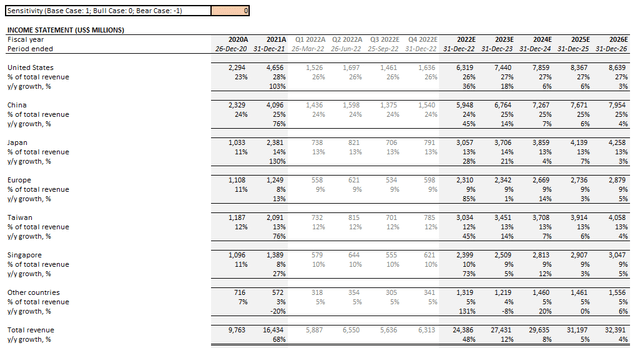
AMD Bull Case Financial Forecast (Author)

AMD Bull Case Financial Forecast (Author)
AMD Bull Case Financial Forecast (Author)
AMD Bull Case Financial Forecast (Author)
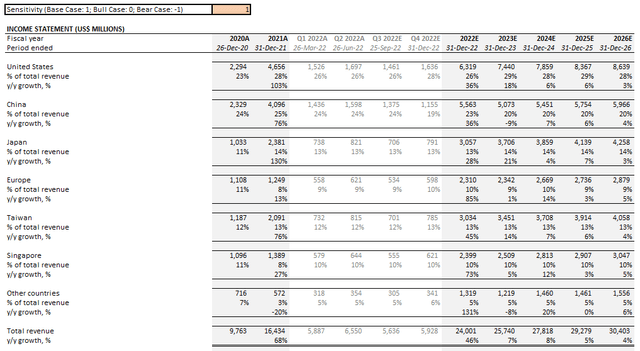
AMD Base Case Financial Forecast (Author)

AMD Base Case Financial Forecast (Author)
AMD Base Case Financial Forecast (Author)
AMD Base Case Financial Forecast (Author)
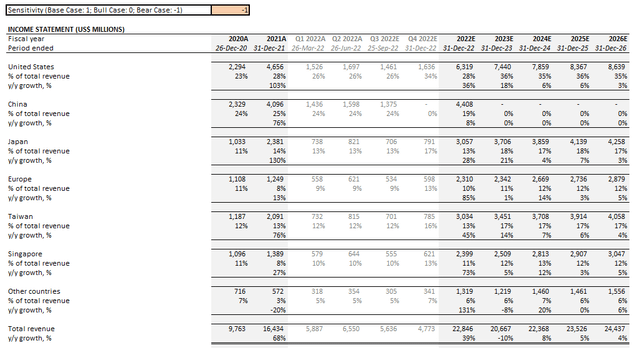
AMD Bear Case Financial Forecast (Author)

AMD Bear Case Financial Forecast (Author)
AMD Bear Case Financial Forecast (Author)
AMD Bear Case Financial Forecast (Author)
Drawing on the above scenarios over AMD’s fundamental prospects sensitized for varying degrees of impact stemming from the newly imposed restrictions, paired with broad-based multiple contraction across the sector under the near-term macroeconomic outlook, our base case price target for the AMD stock is now set at $88. This represents upside potential of 53% based on the stock’s last traded price of $57.55 apiece on October 12. The base case PT assumes an exit multiple of 16.2x EV/EBITDA, which represents a perpetual growth rate of 8%, consistent with market expansion across AMD’s core operating segments and end-user markets, as well as an added premium to peers to reflect its growing market leadership in the provision of chips used in HPC.
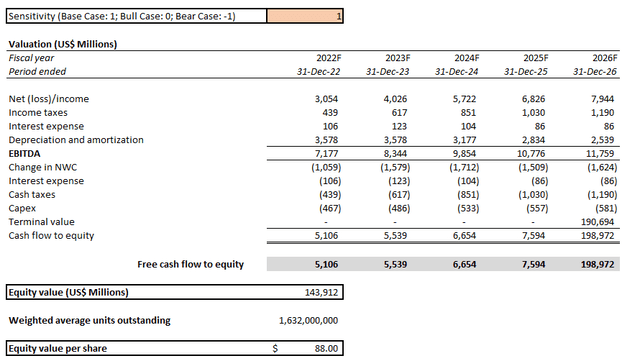
AMD Base Case Valuation (Author)
AMD Base Case Valuation (Author)
Our bull and bear case PT are $93 and $74, respectively, drawing on the fundamental forecast scenarios discussed in the earlier section, while holding key valuation assumptions (i.e. 8% perpetual growth) constant. Our bear case PT reflects that the stock remains undervalued even under the worst combination of the near-term macro-driven slowdown and more pervasive export restrictions to China. This indicates that the stock has likely suffered from a pronounced squeeze to its valuation multiple already amid this year’s rout observed across the semiconductor sector, which is not reflective of its longer-term growth prospects, let alone its premium to peers.

AMD Bull Case Valuation (Author)
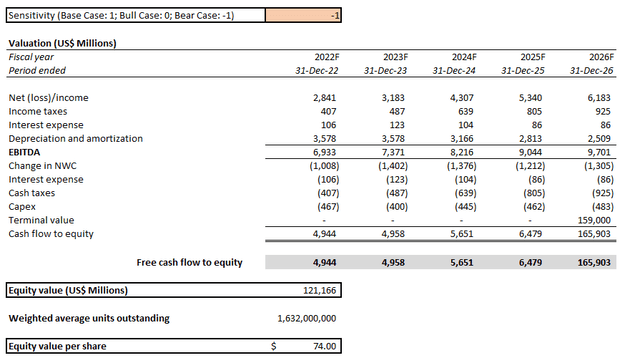
AMD Bear Case Valuation (Author)
AMD Bull Case Valuation (Author)
AMD Bear Case Valuation (Author)
AMD_-_Forecasted_Financial_Information.pdf
Meanwhile, the Nvidia stock has also taken a beating in recent weeks following the announcement of new export restrictions to China, which came on the heels of a weaker-than-expected fiscal 2Q23 and soft forward guidance. As mentioned in our latest coverage on the Nvidia stock, the company’s significant sales exposure in China, paired with the U.S. government’s specific restrictions levied over the export of its best-selling A100 and upcoming H100 server GPUs which would effectively preclude it from previously anticipated capitalization on opportunities stemming from the largest customer of semiconductors, draws significant uncertainties over the company’s forward growth prospects.
With data center sales being a core part of its business that has been providing some alleviation to macro-driven pressure weighing over its gaming segment, the new export restrictions could potentially derail Nvidia’s previous hopes of weathering through the near-term economic downturn with more resilient demand stemming from critical next-generation technologies such as cloud-computing and autonomous driving. As discussed in the earlier section, AMD’s indirect exposure to HPC needs in non-cloud end-markets such as connected mobility already risks severing a sizable chunk of its addressable market, which highlights the extent of greater risks to Nvidia given its more upfront and direct exposure to non-cloud end-markets in China given its global market leadership (> 90%) in the supply of AI solutions (both hardware in the form of processors and supporting software).
Although Nvidia’s CEO Huang has sought to downplay growing investors’ angst over its near-term operational risks in China by pointing to massive opportunities still for the company in the region, the stock’s recent declines imply that a simple positive comment will not be sufficient, and actual performance demonstrating resilience over coming quarters will be required to back the credibility of his statement. This, again, underscores the significant overhang on the Nvidia stock’s near-term performance, given the latest restrictions would not only impact its data center business – which was previously considered its lifeline amid the drastic slowdown in global PC demand – but also its auto segment.
Specifically, Nvidia had just started to see some improvements to its auto segment sales after a lacklustre showing in 1H22, despite the introduction of next-generation systems and platforms such as “NVIDIA DRIVE Orin” aimed at facilitating the development of next-generation autonomous mobility. The segment’s muted results earlier in the year was largely due to industry-wide supply chain constraints that have limited auto productions and their take-rates on Nvidia’s auto solutions. Although auto OEMs have recently observed easing supply chain snarls, which would drive further improvements to Nvidia’s growing auto segment sales, the latest export restrictions to China risks thwarting the emerging business’ potential:
During the fiscal second quarter earnings call, management had alluded to an “$11 automotive design win pipeline” that is expected to drive longer-term growth. Yet, this momentum is expected to experience some bumpiness ahead, as much of it is supported by partnerships with Chinese OEM partners, with the most notable being NIO (NIO), Li Auto (LI), XPeng (XPEV), JIDU, Human Horizons, as well as BYD (OTCPK:BYDDF / OTCPK:BYDDY). Even XPeng founder and CEO He Xiaopeng have recently expressed concerns about the future of autonomous vehicle technology development under the newly imposed U.S. chip export restrictions, underscoring the severity of uncertainties over how U.S.-China chip relations will play out.
Source: “Nvidia: When It Rains, It Pours”
Similar to the bull, base, and bear case scenarios laid out for AMD above, we have applied the same metrics to gauge the extent of potential impact on Nvidia’s near-term financial performance given the newly imposed export restrictions to China. The following scenarios are drawn from the same forecasts laid out and discussed in our latest coverage on the Nvidia stock, adjusted for management’s recent statement that they “do not expect the new controls, including restrictions on sales for highly dense systems [to China], to have a material impact on [Nvidia’s] business”, as well as market forecasts for an average 5% to 8% impact on the sector’s revenues:

Nvidia Bull Case Financial Forecast (Author)
Nvidia Bull Case Financial Forecast (Author)
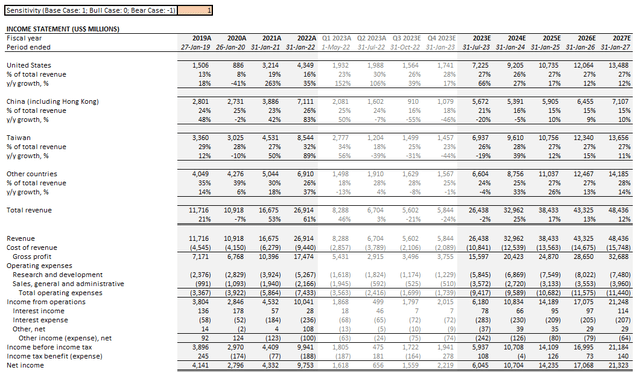
Nvidia Base Case Financial Forecast (Author)
Nvidia Base Case Financial Forecast (Author)

Nvidia Bear Case Financial Forecast (Author)
Nvidia Bear Case Financial Forecast (Author)
Drawing on the above scenarios over Nvidia’s fundamental prospects sensitized for varying degrees of impact stemming from the newly imposed restrictions, paired with broad-based multiple contraction across the sector under the near-term macroeconomic outlook, our base case price target for the Nvidia stock remains at $150. This represents upside potential of 30% based on the stock’s last traded price of $115.00 apiece on October 12. The base case PT assumes an exit multiple of 22.1x EV/EBITDA, which represents a perpetual growth rate of 8%, consistent with the rate applied to gauge AMD’s base case PT and in line with the forecast demand environment across Nvidia’s core operating segments and end-user markets, plus an added premium to peers to reflect its leading market share in the provision of graphics / AI processors.
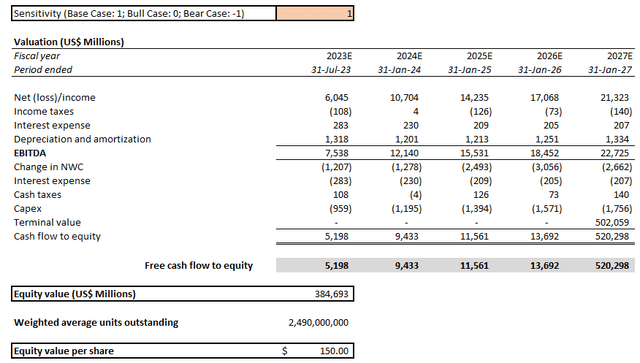
Nvidia Base Case Valuation Analysis (Author)
Nvidia Base Case Valuation Analysis (Author)
Our bull and bear case PT are $160 and $130, respectively, drawing on the fundamental forecast scenarios discussed in the earlier section, while holding key valuation assumptions (i.e. 8% perpetual growth) constant. Similar to the case of AMD, the bear case PT for the Nvidia stock implies that its market price today undercuts the company’s estimated intrinsic value even under the double-whammy of macroeconomic headwinds and regulatory challenges.

Nvidia Bull Case Valuation Analysis (Author)
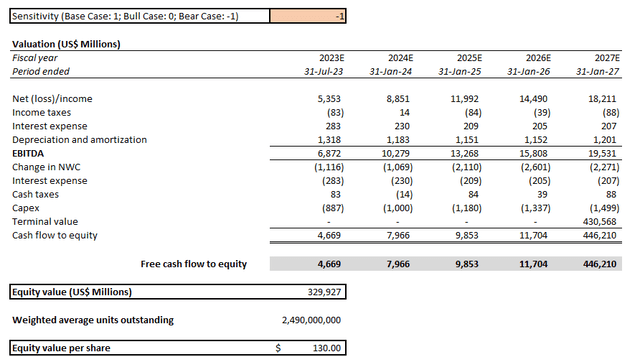
Nvidia Bear Case Valuation Analysis (Author)
Nvidia Bull Case Valuation Analysis (Author)
Nvidia Bear Case Valuation Analysis (Author)
Nvidia_-_Forecasted_Financial_Information.pdf
Based on the foregoing analysis, we believe AMD has less fundamental exposure compared to Nvidia under today’s operating environment, and based on the current extent of the newly implemented restrictions on chip technology sales / export to China. Specifically, AMD is currently less engaged in next-generation AI technologies that could potentially be used in China’s military-based developments in which the U.S. government seeks to curb. However, there is still a risk that the impact of fraying U.S.-China relations on AMD’s fundamental performance could increase over the longer term, given its increasing prominence in HPC. Meanwhile, for Nvidia, although management expects to mitigate adverse impacts from the new rules, its significant exposure to more than 90% of global market share in graphics / AI processors makes its financial performance more susceptible to a broader slowdown as a result of the decreased TAM access ex-China.
From a valuation perspective, we believe AMD continues to trade at a lower valuation multiple in proportion to its growth and profitability prospects compared to Nvidia, which will likely subject the latter to more downside risks in the near-term as market adjusts to the triple-punch from softening PC demand, the new export restrictions, and a broad-based risk-off environment in equities due to rising recession risks. While we believe both stocks remain favourable long-term investments given their critical roles in enabling next-generation high-growth innovations, AMD makes the better one from a valuation perspective under current levels.
Thank you for reading my analysis. If you are interested in interacting with me directly in chat, more research content and tools designed for growth investing, and joining a community of like-minded investors, please take a moment to review my Marketplace service Livy Investment Research. Our service’s key offerings include:
Feel free to check it out risk-free through the two-week free trial. I hope to see you there!
This article was written by
Boutique investment research shop providing professional coverage on disruptive thematic equities. Our analysis provides a deep dive on growth drivers present in the secular market to identify outperforming investments.
Disclosure: I/we have a beneficial long position in the shares of AMD, NVDA either through stock ownership, options, or other derivatives. I wrote this article myself, and it expresses my own opinions. I am not receiving compensation for it (other than from Seeking Alpha). I have no business relationship with any company whose stock is mentioned in this article.